Accelerated Acid Etch for Automotive Clearcoats
Etches are formed when material is lost from the coating surface. This material is lost as a result of acid-catalyzed hydrolysis of the chemical bonds within the coating. When enough bonds are broken, polymer molecules or fragments become detached from the rest of the coating and are washed away. The lost material is greatest at the edge of water droplets where the acid concentrates during evaporation. This leads to the familiar ring or "water spot" pattern.
Most successful work on improving the acid etch resistance of automotive coatings has focused on reformulation to reduce or eliminate the acid-sensitive sites within the polymer network. Most automotive coatings are comprised of a highly pigmented color coat (or basecoat) that is covered with a transparent clearcoat.
Blount Island Exposures
Summertime on Blount Island in Jacksonville, Fla., is, and continues to be, one of the most severe locations in North America for the conditions that cause acid etch. As a result, this location is the site for numerous annual field tests to assess the performance of automotive coatings for acid etch resistance. Varying numbers of hoods, panels and fascia are placed in Jacksonville each year by automotive OEMs and their suppliers. The hoods, panels and fascia vary in size and shape, but are mostly black to create the worst-case scenario for etch testing. The items are exposed in a variety of ways, but typically tested between 0 and 5 degrees horizontal. The typical testing period is approximately 14 weeks, from June to September of each year. The test specimens are rated for etch damage at varying times throughout the 14-week period using a visual method of evaluation with standard panels used as a guide. While the Blount Island exposures have the benefit of real-world testing, there are significant limitations to the current procedure in terms of product development. In addition to the inconvenience of a single location and narrow time frame for testing, the results of this annual test vary like the weather.Accelerated Acid Etch
Many attempts have been made at developing laboratory techniques to predict etch resistance of automotive clearcoats. There are a number of methods currently used in the industry, like the Gradient Bar Test, the Acid Spot Test, etc. None of these tests have included all of the field components that contribute to the etching of automotive clearcoats - humidity, UV light, specimen orientation, acidic solution.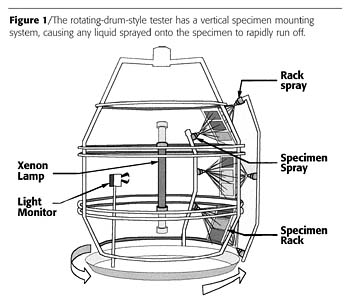
Development of Current Test
BASF recognized the need for a realistic laboratory-accelerated acid etch test procedure and began to quantify the critical elements. Many of the critical test parameters could be reproduced in existing xenon arc test chambers.
Since the 1950s, xenon arc testers have been used to test the weatherability of coatings. These devices have attained significant popularity because they utilize a light source which, when properly filtered, provides an excellent simulation of the full spectrum of sunlight. Traditionally, these devices have a xenon light placed in the center of the chamber and the test specimens mounted vertically on a framework that revolves around the light source, like a carousel. This mechanism is often called a "rotating drum" style tester (Figure 1), and is available in many models from several manufacturers. Unfortunately, the vertical specimen mounting system means any liquid sprayed onto the specimen tends to rapidly run off.
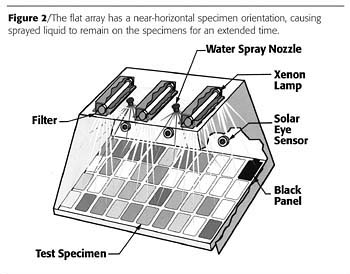
It was recognized that this flat-array xenon would be particularly useful for reproducing the acid rain effects seen on horizontal specimens in Jacksonville. Because of Q-Panel's experience in weathering science, correlation studies and tester design, BASF partnered with Q-Panel to embark on a joint effort to develop a realistic accelerated acid etch test procedure.
Quantifying the Exposure Environment
BASF has been monitoring the exposure conditions at the Jacksonville exposure site for a number of years. Based on that data, the following are the critical environmental conditions that were considered in the development of a new BASF Accelerated Acid Test procedure.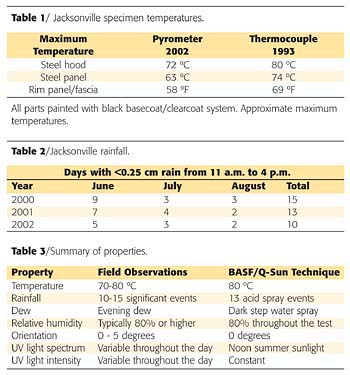
Temperature
Early on, we recognized the importance of the effect of temperature on the Jacksonville field exposure results. Consequently, temperature parameters were quantified by taking real-time measurements of the actual specimens that were exposed in Jacksonville (Table 1). In 1993, thermocouple measurements produced specimen temperatures as high as 80 °C. In 2002, Jacksonville pyrometer measurements of actual parts and test panels, under field conditions, show the maximum specimen temperatures to be approximately 72°C. As a result of this data, 80 °C was chosen as the target Uninsulated Black Panel2 temperature for the light exposure step of the lab test.Rainfall
We identified the need to use a simulated rain solution with a specific pH and chemical composition known to produce etch in Jacksonville. Field observations indicated that trace rainfall of less than 0.25 cm (< 0.1 inch) and low cloud cover are the conditions most responsible for producing acid etch in Jacksonville. Studies determined that lower pH rainfalls are the most responsible for producing etch (e.g., 3.49 pH collected in Jacksonville in 1989). Weather data from Jacksonville indicates that, between June and August, there are an average of 10-15 days of this type every year (Table 2).
The pH and chemical composition of the simulated acid rain solution used for the accelerated laboratory method was based on an analysis of actual Jacksonville rain samples.
Humidity and Wet Time
Research indicated a need to maintain a relative humidity that is consistent with Jacksonville's natural exposure environment. This would best mimic the prolonged dry off seen in the field. Weather data shows that the relative humidity averages approximately 80% during the summer months (June-August).Time of wetness (TOW) research from Florida and other locations indicates that test specimens are wet more than 50% of the time and that the source of this wetness is dew (Grossman, 1978). Field observations confirmed this by determining that, on most summer evenings, dew forms on the parts and panels. Typically, the dew is still in place the following morning.
Therefore, in the lab simulation, a series of pure water sprays during the dark step are used to simulate the evening dew. At the same time, a high humidity of 80% is maintained throughout the test to simulate the summer conditions in Jacksonville.
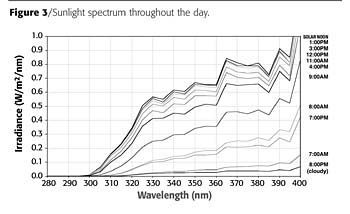
Specimen Orientation
Panels and parts exposed outdoors in Jacksonville are positioned at the horizontal or near-horizontal orientation angles that give severe etch effect. Typically, the most severe etching is observed at 0 to 5 degrees exposure.
To reproduce the most severe field exposure condition for the accelerated test, the Q-Sun test chamber was modified to orient the test specimens at 0 degrees. (This is a modification from the normal Q-Sun exposure angle of 10 degrees.)

UV Light
Q-Panel's experience dictated that, for the best correlation to outdoor results, the lab specimens should be exposed to UV light with a similar Spectral Power Distribution (SPD) and intensity to that which is seen in the field (Table 3). Q-Panel research on sunlight spectrum shows that, although the spectrum of daylight changes minute by minute throughout the day (Figure 3), the peak solar noon summer sunlight maximum is approximately 0.68 W/m2/nm @340 nm. Q-Panel's measurements are in essential agreement with CIE 85, Table 4 and with the new SMART2 spectra currently proposed by ASTM Committee G 03.
Some older automotive test methods like SAE J1960 use an "extended UV" xenon spectrum to accelerate the coating degradation, (Figure 4). This spectrum has the disadvantage of producing short-wavelength UV below the solar cut-on point of 295 nm. Experience has taught us that this spectrum can cause unnatural results for some coatings. Consequently, more recent test protocols, like SAE J2527, allow for a more realistic spectrum by specifying the Daylight Filter described in ASTM G 155 (Figure 5). (This is the same spectrum specified in ISO 4892-2 and ISO 11341). The Daylight Filter spectrum was chosen for the new BASF Accelerated Acid Test procedure because of its close match with natural sunlight.
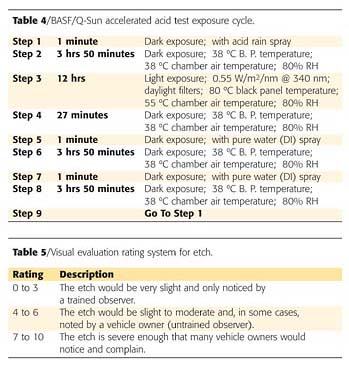
Experimental Development
BASF developed a simulated acid rain solution that was based on the observed acid rain chemistry in Jacksonville and provided Q-Panel an initial set of test specimens coated with four types of clearcoat systems.The Q-Sun Xenon Test Chamber was modified into a new model to incorporate the features dictated by field observations. A 0 degree specimen mounting plane and a dual spray system were added. The dual spray system can be programmed to automatically spray either pure DI water or simulated acid rain solution.
Using the modified Q-Sun test chamber, Q-Panel experimented with various test cycles, including 100% light, with intermittent acid spray. Q-Panel determined that a cycle with both a light and a dark time exposure gave better correlation to the outdoor etch results from Jacksonville. The volume and frequency of acid spray was adjusted to best simulate the outdoor results.
After some Edisonian Research, an optimized exposure cycle was developed. After the cycle was determined, the test specimens were exposed in the Q-Sun and evaluated at intervals of 200, 300, 400, 500, 600 and 700 hours.
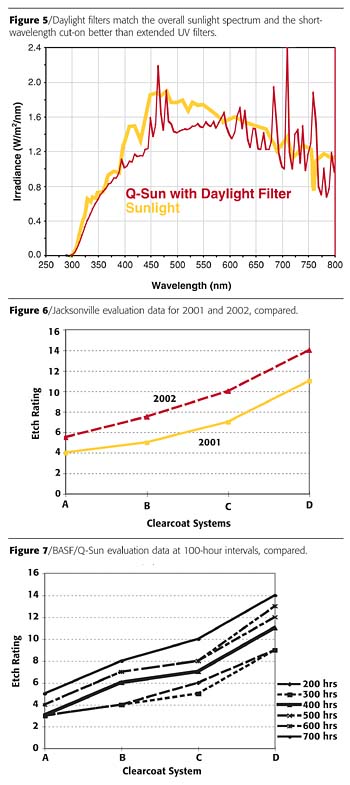
Acid Etch Evaluation Procedure
The evaluation of acid damage is performed visually and the test specimen is rated on a scale from 0 (best) to 10 (worst). A summary of the rating scale is described in Table 5.
For certain tests, the scale was extended to allow for finer discrimination.
Exposure Results Compared
Jacksonville Data
Data from two years' Jacksonville natural exposures were compared to establish a baseline. As expected, there were differences from year to year in the absolute values. However, there was perfect agreement in the rank order of the various systems from year to year (Table 6 and Figure 6).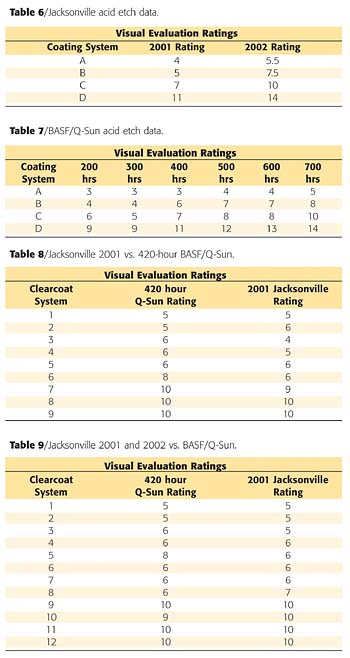
BASF Accelerated Acid Test Results
The test specimens were rated at 100-hour intervals, beginning at 200 hours. The results are shown in Table 7 and Figure 7. After 200 hours in the Q-Sun, the relative rank order was well established and remained unchanged throughout the exposure period.
The accelerated acid test results were compared to actual Jacksonville natural exposure data. As seen in the figures, after only 200 hours in the Q-Sun, the BASF accelerated acid test procedure gave the same ranking as the Jacksonville exposures. After 400 hours, it produced both the correct Spearman rank order (rho = 1.0) and approximately the same level of etching as seen after 14 weeks of the 2001 Jacksonville exposure (Figures 8 and 9). Test results for 700 hours were essentially identical to 2002 Jacksonville data (Figure 10).
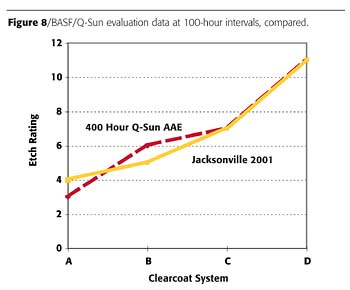
Expanded Testing
Because of the excellent results, the test was expanded to include more clearcoat systems for which Jacksonville data was already available. To establish a benchmark, the Jacksonville 2001 and 2002 data were compared using both Pearson and Spearman correlation methods. For data of this type, the authors believe that Pearson's method is the more useful. The data sets exhibited a Pearson's correlation coefficient of 0.88 and a Spearman rank order coefficient of 0.72.The same systems were exposed for 420 hours to the BASF Accelerated Acid Test procedure.
The Q-Sun results agreed with the 2001 Jacksonville results with a Pearson's correlation of 0.90 and a Spearman's rank order coefficient of 0.80 (Table 8).
When the BASF Accelerated Acid Test ratings were compared to the average of the 2001 and 2002 Jacksonville results, the correlation was even better (Table 9). Pearson R2 = 0.93 and Spearman rho = 0.80. In short, the BASF Accelerated Acid Test results agreed with Jacksonville as well as, or better than, Jacksonville agreed with itself.
Summary and Conclusions
A new BASF Accelerated Acid Test procedure was developed jointly by BASF and Q-Panel Lab Products. The procedure identified and incorporated all of the known critical test parameters. In order to accomplish this, BASF developed a simulated acid rain solution and Q-Panel modified the Q-Sun Xenon Test Chamber. Correlation between the new procedure and the Jacksonville natural exposures are better than, or equal to, the correlation between Jacksonville year to year results.The development of the new procedure has a number of significant benefits to industry:
-
1. It allows for faster development of etch-resistant coatings. As many as 20 iterations per year of formulate/test/reformulate vs. current one iteration per year, as dictated by natural Jacksonville exposures.
2. The relatively pristine condition of specimens tested in the lab allows for the use of digital evaluation of etches. The Jacksonville panels cannot practically use this technique due to scratches, dirt, etc.
3. It is expected that this BASF Accelerated Acid Etch Test can be used to simulate other acid rain environments, where the rain chemistry differs from Jacksonville.
4. The new procedure allows the possibility of consistent monitoring of assembly plant systems for etch as an "early warning system."
5. Ultimately, because of the new test procedure, there should be fewer acid etch failures in service.
End Notes
1 For a full comparison of the two different approaches to xenon arc chamber construction, see Brennan et al, 2003.
2 For a definition of an Uninsulated Black Panel Thermometer, see ASTM G 151.
Acknowledgments
The authors would like to acknowledge the following contributors to the BASF Accelerated Acid Test development:
- BASF Corporation
Q-Panel Lab Products
P. Deskovitz
D. Fayak
L. Pattison
G. Fedor
T. Richards
D. Grossman
H. Valatka
J. Quill
R. Roberts
1. ASTM G 151, Standard Practice for Exposing Nonmetallic Materials in Accelerated Test Devices that Use Laboratory Light Sources.
2. ASTM G 155, Standard Practice for Operating Xenon Arc Light Apparatus for Exposure of Nonmetallic Materials.
3. Brennan, P. J, Static and Rotating Xenon Arc Exposures Compared: technical issues, practical considerations, and how different types of hardware comply to the new performance-based test methods. 1st European Weathering Symposium. Prague, Czech Republic.
4. CIE 85, Table 4. Publication Number 85: 1989, Technical Report - Solar Spectral Irradiance.
5. Grossman, P. R. Investigation of Atmospheric Exposure Factors that Determine Time-of-Wetness of Outdoor Structures, in Atmospheric Factors Affecting the Corrosion of Engineering Materials, ASTM STP 646, Coburn, S. K., Ed., American Society of Testing and Materials, 1978.
6. ISO 4892-2, Plastics - Methods of exposure to laboratory light sources -Part 2: Xenon-arc sources.
7. ISO 11341, Paints and varnishes - Artificial weathering and exposure to artificial radiation - Exposure to filtered xenon-arc radiation.
8. SAE J1960, Accelerated Exposure of Automotive Exterior Material Using a Controlled Irradiance Water-Cooled Xenon- Arc Apparatus.
9. SAE J2527, Accelerated Exposure of Automotive Exterior Materials Using a Controlled Irradiance Xenon Arc Apparatus.
10.Test Methods are available from the following organizations:
- ASTM International, 100 Barr Harbor Drive, West Conshohocken PA 19425, USA.
- ISO, Case Postale 56, CH-1211 Geneve 20, Switzerland.
- SAE International, 400 Commonwealth Drive, Warrendale, PA 15096.
A U.S. Patent has been filed jointly by BASF Corporation and Q-Panel Lab Products that covers this test method and apparatus. Under the terms of the Joint Development Agreement between BASF Corporation and Q-Panel Lab Products, BASF Corporation has exclusive use of this test method until July 16th, 2005. Q-Sun is a registered trademark of Q-Panel Lab Products.
This paper was presented at the International Waterborne, High-Solids and Powder Coatings Symposium sponsored by The University of Southern Mississippi, Department of Polymer Science, February 2005, New Orleans, La.
Looking for a reprint of this article?
From high-res PDFs to custom plaques, order your copy today!



